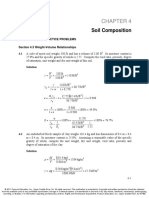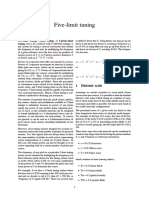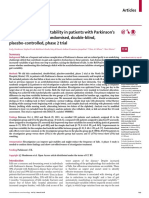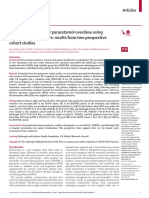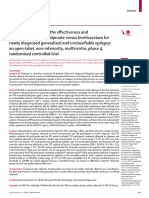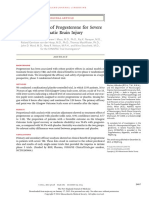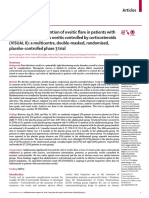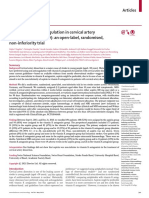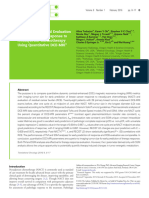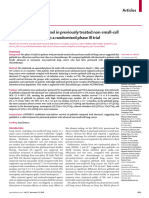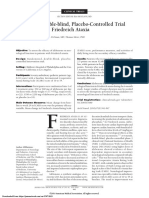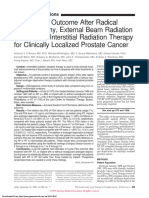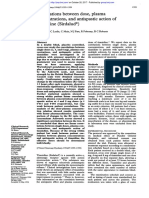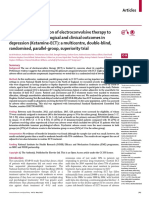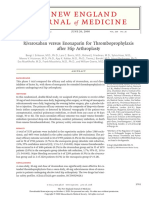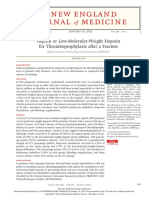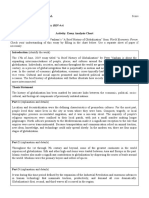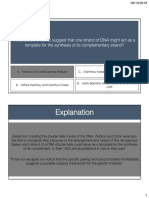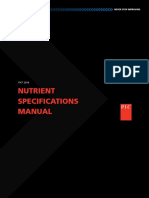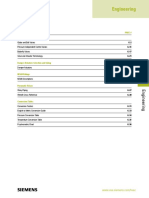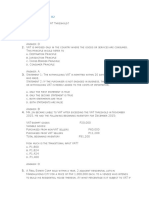1 s2.0 S014067362300569X Main
1 s2.0 S014067362300569X Main
Uploaded by
Aldo Amed Montaño SalinasCopyright:
Available Formats
1 s2.0 S014067362300569X Main
1 s2.0 S014067362300569X Main
Uploaded by
Aldo Amed Montaño SalinasOriginal Title
Copyright
Available Formats
Share this document
Did you find this document useful?
Is this content inappropriate?
Copyright:
Available Formats
1 s2.0 S014067362300569X Main
1 s2.0 S014067362300569X Main
Uploaded by
Aldo Amed Montaño SalinasCopyright:
Available Formats
Articles
Sparsentan in patients with IgA nephropathy: a prespecified
interim analysis from a randomised, double-blind, active-
controlled clinical trial
Hiddo J L Heerspink, Jai Radhakrishnan, Charles E Alpers, Jonathan Barratt, Stewart Bieler, Ulysses Diva, Jula Inrig, Radko Komers, Alex Mercer,
Irene L Noronha, Michelle N Rheault, William Rote, Brad Rovin, Howard Trachtman, Hernán Trimarchi, Muh Geot Wong, Vlado Perkovic, for the
PROTECT Investigators*
Summary
Background Sparsentan is a novel, non-immunosuppressive, single-molecule, dual endothelin and angiotensin Published Online
receptor antagonist being examined in an ongoing phase 3 trial in adults with IgA nephropathy. We report the April 1, 2023
https://doi.org/10.1016/
prespecified interim analysis of the primary proteinuria efficacy endpoint, and safety. S0140-6736(23)00569-X
See Online/Comment
Methods PROTECT is an international, randomised, double-blind, active-controlled study, being conducted in https://doi.org/10.1016/
134 clinical practice sites in 18 countries. The study examines sparsentan versus irbesartan in adults (aged ≥18 years) S0140-6736(23)00630-X
with biopsy-proven IgA nephropathy and proteinuria of 1·0 g/day or higher despite maximised renin-angiotensin *PROTECT Investigators are
system inhibitor treatment for at least 12 weeks. Participants were randomly assigned in a 1:1 ratio to receive listed in the appendix (pp 2–5)
sparsentan 400 mg once daily or irbesartan 300 mg once daily, stratified by estimated glomerular filtration rate at Department of Clinical
screening (30 to <60 mL/min per 1·73 m² and ≥60 mL/min per 1·73 m²) and urine protein excretion at screening Pharmacy and Pharmacology,
University of Groningen,
(≤1·75 g/day and >1·75 g/day). The primary efficacy endpoint was change from baseline to week 36 in urine protein– Groningen, Netherlands
creatinine ratio based on a 24-h urine sample, assessed using mixed model repeated measures. Treatment-emergent (Prof H J L Heerspink PhD); The
adverse events (TEAEs) were safety endpoints. All endpoints were examined in all participants who received at least George Institute for Global
one dose of randomised treatment. The study is ongoing and is registered with ClinicalTrials.gov, NCT03762850. Health, University of New
South Wales, Sydney, NSW,
Australia (Prof H J L Heerspink,
Findings Between Dec 20, 2018, and May 26, 2021, 404 participants were randomly assigned to sparsentan (n=202) or Prof V Perkovic MD,
irbesartan (n=202) and received treatment. At week 36, the geometric least squares mean percent change from H Trimarchi MD); Division of
Nephrology, Columbia
baseline in urine protein–creatinine ratio was statistically significantly greater in the sparsentan group (–49·8%) than
University, New York, NY, USA
the irbesartan group (–15·1%), resulting in a between-group relative reduction of 41% (least squares mean ratio=0·59; (Prof J Radhakrishnan MD);
95% CI 0·51–0·69; p<0·0001). TEAEs with sparsentan were similar to irbesartan. There were no cases of severe Department of Laboratory
oedema, heart failure, hepatotoxicity, or oedema-related discontinuations. Bodyweight changes from baseline were Medicine and Pathology,
University of Washington,
not different between the sparsentan and irbesartan groups.
Seattle, WA, USA
(Prof C E Alpers MD);
Interpretation Once-daily treatment with sparsentan produced meaningful reduction in proteinuria compared with Department of Cardiovascular
irbesartan in adults with IgA nephropathy. Safety of sparsentan was similar to irbesartan. Future analyses after Sciences, University of
Leicester General Hospital,
completion of the 2-year double-blind period will show whether these beneficial effects translate into a long-term
Leicester, UK
nephroprotective potential of sparsentan. (Prof J Barratt PhD); Travere
Therapeutics, San Diego, CA,
Funding Travere Therapeutics. USA (S Bieler BA, U Diva PhD,
J Inrig MD, R Komers MD,
W Rote PhD); JAMCO Pharma
Copyright © 2023 Published by Elsevier Ltd. All rights reserved. Consulting, Stockholm,
Sweden (A Mercer PhD);
Introduction proteinuria of 1 g/day or higher have a greater risk of Laboratory of Cellular, Genetic,
and Molecular Nephrology,
Immunoglobulin A (IgA) nephropathy is the most disease progression, and additional treatment is Division of Nephrology,
common primary glomerulonephritis and an important recommended. University of São Paulo School
cause of kidney failure.1,2 Proteinuria has been The use of RAS inhibitors as standard of care in IgA of Medicine, São Paulo, Brazil
consistently shown to be a risk factor for progressive nephropathy is based on their well established pleiotropic (Prof I L Noronha MD); Division
of Pediatric Nephrology,
kidney function loss in patients with IgA nephropathy,2 nephroprotective actions in a variety of kidney diseases University of Minnesota
and remission of proteinuria is associated with improved and indicates a contribution of its main effector, Medical School, Minneapolis,
kidney outcomes.3 Despite the risk of progressive kidney angiotensin II, in the pathophysiology of IgA nephropathy.5 MN, USA (M N Rheault MD);
disease and kidney failure, few therapeutic options are More recently, advances in our understanding of the Division of Nephrology, Ohio
State University Wexner
available. The Kidney Disease Improving Global pathogenesis of IgA nephropathy show that endothelin-1 Medical Center, Columbus, OH,
Outcomes (KDIGO) guideline recommends the use of (ET-1) contributes to the pathophysiology of IgA USA (Prof B Rovin MD); Division
renin-angiotensin system (RAS) inhibitors in patients nephropathy via activation of ETA receptors, leading to a of Nephrology, Department of
with proteinuria more than 0·5 g/day.4 Following variety of effects including vasoconstriction, podocyte Pediatrics, University of
Michigan, Ann Arbor, MI, USA
3 months of RAS inhibitor treatment, patients with dysfunction, tubular injury, inflammation, and fibrosis.6
www.thelancet.com Published online April 1, 2023 https://doi.org/10.1016/S0140-6736(23)00569-X 1
Articles
(Prof H Trachtman MD);
Nephrology Service, Hospital Research in context
Británico de Buenos Aires,
Buenos Aires, Argentina Evidence before this study sparsentan versus maximum labelled or tolerated irbesartan in
(H Trimarchi); Department of We searched PubMed for randomised controlled trials published adults with biopsy-proven IgA nephropathy. The prespecified
Renal Medicine, Concord between Jan 1, 2013, and Feb 1, 2023, with the terms analysis of the interim primary proteinuria efficacy endpoint
Repatriation General Hospital,
Concord, NSW, Australia
“immunoglobulin A nephropathy” AND “treatment” AND shows that sparsentan treatment achieved a meaningful and
(M G Wong PhD); Concord “randomized controlled trial”. Proteinuria of 1 g/day or higher is a statistically significant 41% reduction in proteinuria versus
Clinical School, University of risk factor for progressive kidney function loss in patients with irbesartan from baseline to week 36. The reduction in
Sydney, Concord, NSW, IgA nephropathy. Previous studies have shown that remission of proteinuria was greater with sparsentan compared with
Australia (M G Wong); Faculty
of Medicine & Health,
proteinuria is associated with improved kidney outcomes; irbesartan from the first post-randomisation visit at week 4
University of New South Wales however, few therapeutic options are available for patients who through to week 36 of the interim analysis. Proteinuria
Sydney, Sydney, NSW, Australia do not respond to standard-of-care treatment with renin- reduction with sparsentan treatment was consistent across
(Prof V Perkovic) angiotensin system (RAS) inhibitors. Clinical trials have primarily patient subgroups of baseline demographic and clinical
Correspondence to: examined immunosuppressive therapies, some of which have characteristics. No increases in bodyweight were observed with
Prof Hiddo J L Heerspink,
been shown to reduce proteinuria and kidney function loss but sparsentan compared with irbesartan. Overall, safety of
Department of Clinical Pharmacy
and Pharmacology, University of are associated with side-effects. Preclinical and clinical studies sparsentan was similar to irbesartan.
Groningen, 9700 RB Groningen, provide a strong rationale for simultaneous antagonism of the
Netherlands Implications of all the available evidence
endothelin and renin-angiotensin systems that jointly target IgA
h.j.lambers.heerspink@umcg. The ongoing PROTECT phase 3 clinical trial is among the
nephropathy pathophysiology as a novel treatment for IgA
nl largest interventional trials testing a novel drug versus an
nephropathy. Sparsentan is a novel, single-molecule, dual
See Online for appendix active comparator in IgA nephropathy to date.
endothelin and angiotensin receptor antagonist that has been
The prespecified interim analysis demonstrates the efficacy
shown to reduce proteinuria in patients with focal segmental
and safety of sparsentan in adults with IgA nephropathy,
glomerulosclerosis in the DUET trial. These findings informed the
showing a robust and meaningful reduction in proteinuria
design of the ongoing phase 3 PROTECT trial in adults with IgA
with sparsentan treatment and a safety profile similar to that
nephropathy who have proteinuria of 1·0 g/day or higher despite
of irbesartan. The findings support a potential longer-term
maximised RAS inhibitor treatment for at least 12 weeks.
kidney protective effect, which will be further examined at
Added value of this study the completion of the 2-year double-blind period of the
PROTECT, an international, randomised, double-blind, active- PROTECT trial.
controlled study, is the first head-to-head clinical trial of
Similar to RAS inhibitors, ETA receptor antagonists have antagonism of endothelin and renin-angiotensin
shown a wide range of beneficial effects in various models systems.18 These findings informed the design of a
of glomerular diseases.7–9 Therefore, a strong rationale phase 3 trial to characterise the long-term efficacy and
exists for a therapeutic approach with simultaneous safety of sparsentan in slowing kidney function decline
antagonism of these two pathways that act in tandem, in in patients with IgA nephropathy who are at higher risk
order to protect kidney function. Indeed, the actions of of disease progression due to proteinuria of 1 g/day or
RAS inhibitors and ETA receptor antagonists in higher despite maximally tolerated treatment with RAS
combination have demonstrated additional benefits in inhibitors.19,20 The primary and confirmatory endpoints of
experimental models of kidney disease8,10 and in patients the trial, proteinuria reduction and rate of decline in
with both diabetic and non-diabetic nephropathies, estimated glomerular filtration rate (eGFR), respectively,
including IgA nephropathy.11–14 were selected on the basis of emerging evidence
Sparsentan is a non-immunosuppressive, single- supporting these endpoints as surrogates for kidney
molecule, dual endothelin and angiotensin II receptor failure.21–23 We here report the analysis of the primary
antagonist with high selectivity for the ETA receptor and efficacy endpoint and interim safety results of the trial.
angiotensin II subtype 1 receptor (AT1 receptor) being
developed for the treatment of focal segmental Methods
glomerulosclerosis and IgA nephropathy that recently Study design and participants
received accelerated approval by the US Food and Drug The phase 3 PROTECT trial is an international,
Administration for the reduction of proteinuria in adults multicentre, randomised, double-blind, parallel-group,
with IgA nephropathy at high risk of disease active-controlled clinical trial designed to evaluate the
progression.15–17 In the phase 2 DUET clinical trial of efficacy and safety of sparsentan (400 mg once daily)
sparsentan versus irbesartan in focal segmental versus the active control irbesartan (300 mg once daily)
glomerulosclerosis, sparsentan statistically significantly in adults with IgA nephropathy who continue to have
reduced proteinuria with a favourable safety profile, persistent proteinuria despite receiving maximised
supporting nephroprotective actions of simultaneous treatment with angiotensin-converting enzyme (ACE)
2 www.thelancet.com Published online April 1, 2023 https://doi.org/10.1016/S0140-6736(23)00569-X
Articles
inhibitors or angiotensin receptor blockers (ARBs). The committee, the serious adverse event monitoring contact,
study is being conducted in 134 clinical practice sites in and the limited unmasked team responsible for the
18 countries; individuals were screened at a total of conduct of the prespecified interim analysis; members of
156 sites. Details of the study design and methods and this team were precluded from further participation in
aggregated patient baseline characteristics have been study-related activities after gaining access to unmasked
previously reported and are briefly reviewed here.19,20 information. Sparsentan and irbesartan were packaged
The study duration of 270 weeks includes a double- identically with uniform capsule appearance (study
blind period of 114 weeks (final patient visit expected in medication was over-encapsulated with size 00 capsules),
the second half of 2023) followed by an open-label labelling, and administration schedule.
extension period of up to 156 weeks (appendix p 6). A
prespecified interim analysis was performed on the Procedures
primary efficacy endpoint of change in proteinuria at Enrolled patients discontinued RAS inhibition and any
week 36 to form the basis of an application for approval other prohibited concomitant medications (appendix p 7)
of sparsentan. The current interim analysis of the before the randomisation visit. Participants received half of
primary efficacy endpoint includes available efficacy data the study drug target dose (ie, 200 mg once daily of
through to the cutoff date of Aug 1, 2021, and available sparsentan; 150 mg once daily of irbesartan) as the initial
safety data through to the cutoff date of Feb 1, 2022. dose for the first 2 weeks of treatment. Titration to the
We enrolled male or female adult participants (aged target dose of 400 mg once daily of sparsentan or 300 mg
≥18 years) with biopsy-proven IgA nephropathy (without once daily of irbesartan occurred at the end of week 2
restriction on the timing of the kidney biopsy), a following evaluation of dose tolerance, defined as systolic
24-h urine protein excretion value of 1·0 g/day or higher blood pressure higher than 100 mm Hg and diastolic blood
at screening despite at least 12 weeks with a stable dose pressure higher than 60 mm Hg and no treatment-
of RAS inhibition, and an eGFR of at least 30 mL/min emergent adverse events (TEAEs), such as worsening
per 1·73 m² at screening. Eligible participants were using oedema or laboratory findings (eg, serum potassium
a stable dose of ACE inhibitor or ARB therapy (or both) >5·5 mEq/L). Participants with asymptomatic blood
for at least 12 weeks before screening that was (1) the pressure values of 100/60 mm Hg or lower, or with clinical
patient’s maximum tolerated dose and (2) at least half of symptoms of orthostatic hypotension, continued the initial
the maximum labelled dose; and at screening, they had a dose. Dose titrations (down or back up) were permitted at
systolic blood pressure of 150 mm Hg or lower and any time at the investigator’s discretion. During follow-up,
diastolic blood pressure of 100 mm Hg or lower. We blood pressure-lowering medications could be initiated or
excluded individuals with IgA nephropathy secondary to adjusted at the discretion of the investigator to reach the
another condition or IgA vasculitis, cellular glomerular guideline-recommended blood pressure target of
crescents in more than 25% of glomeruli on kidney 125/75 mm Hg.4 Study visits occurred at weeks 2, 4, and 6,
biopsy within 6 months before screening, or a cause of followed by week 12 and every 12 weeks thereafter.
chronic kidney disease in addition to IgA nephropathy. Proteinuria and albuminuria were assessed by 24-h urine
Other key exclusion criteria were any systemic collection at each study visit and analysed at a central
immunosuppressive medications for more than 2 weeks laboratory (Q2 Solutions, Valencia, CA, USA). Protocol
within 3 months before screening, or major hepatic, deviations are summarised in the appendix (p 8).
cerebrovascular, or cardiovascular (including New York
Heart Association Class II–IV heart failure) conditions. Outcomes
Participants were enrolled following institutional review The primary efficacy endpoint of change from baseline
board or ethics committee approvals at each investigation in urine protein–creatinine ratio based on a 24-h urine
site in accordance with Good Clinical Practice and the sample at week 36 was assessed in a prespecified interim
Declaration of Helsinki. All participants provided written analysis after 280 participants had undergone the week
informed consent before study enrolment. 36 visit. A secondary efficacy endpoint of change from
baseline in urine albumin–creatinine ratio based on a
Randomisation and masking 24-h urine sample at week 36, and prespecified
We randomly assigned participants in a 1:1 ratio to receive exploratory endpoints of complete (urinary protein
sparsentan 400 mg once daily or irbesartan 300 mg excretion <0·3 g/day) and partial (urinary protein
once daily using a predefined computer-generated excretion <1·0 g/day) proteinuria remission at least once
randomisation schedule, which stratified the allocation by at any time during the double-blind period were also
screening eGFR value (30 to <60 mL/min per 1·73 m² and examined. Another secondary efficacy endpoint
≥60 mL/min per 1·73 m²) and screening urine protein examined in this interim analysis was the proportion of
excretion (≤1·75 g/day and >1·75 g/day). All parties patients reaching a confirmed 40% reduction in eGFR
involved with the conduct of the study remain masked to from baseline, kidney failure (defined as initiation of
participant treatment allocation for the double-blind kidney replacement therapy or sustained eGFR value of
period, with the following exceptions: the data monitoring <15 mL/min per 1·73 m²), or all-cause mortality.
www.thelancet.com Published online April 1, 2023 https://doi.org/10.1016/S0140-6736(23)00569-X 3
Articles
Safety outcomes included TEAEs, serious TEAEs, randomised treatment (analyses based on randomised
TEAEs that led to treatment discontinuation, and treatment assignment). The full analysis set (all patients
prespecified liver function testing adverse events of who took at least one dose of randomised therapy;
interest—increase in alanine aminotransferase (ALT) or analyses based on randomised treatment assignment)
aspartate aminotransferase (AST) to more than three and the safety analysis set (all patients who took at least
times the upper limit of normal with or without elevation one dose of randomised therapy; analyses based on
of total serum bilirubin to more than two times the upper randomised treatment) were equivalent to the primary
limit of normal. TEAEs were coded with the MedDRA analysis population at the data cutoff for the interim
Dictionary (version 23.0). Changes from baseline in analysis. All statistical analyses were performed using
bodyweight and in systolic and diastolic blood pressure SAS (version 9.4 or later). A mixed model repeated
were examined. measures (MMRM) analysis was used to evaluate change
from baseline to week 36 in urine protein–creatinine ratio
Statistical analysis (primary efficacy endpoint) using available data from all
A sample size of 280 randomly assigned participants participants at the data cutoff. Fixed effects in the model
provides at least 90% power to test that the true relative included randomised treatment group, baseline log(urine
treatment effect on proteinuria, for sparsentan versus protein–creatinine ratio), time, treatment group by time
irbesartan, is at least 30%.19 A sample size of interaction, and randomisation stratification (four levels).
approximately 380 randomly assigned participants Analyses were performed on log-transformed data, and
provides at least 90% power to detect an underlying results were back-transformed to present treatment
treatment effect of 2·9 mL/min per 1·73 m² per year for effects on the ratio scale. Under the assumption of
the planned secondary efficacy analysis of rate of change missing at random, missing data were imputed using the
of eGFR (total eGFR slope) at the completion of the multiple imputation procedure for the urine protein–
double-blind period. Additional details related to sample creatinine ratio in the natural log scale. The treatment
size and power analysis are provided in the appendix (p 8). effect is the difference between sparsentan and irbesartan
The primary analysis set was used for all analyses and geometric least squares means at week 36. Additional
included all participants who received at least one dose of details of the statistical methods are provided in the
671 patients assessed for eligibility
265 excluded*
122 urinary protein excretion <1 g per day
59 eGFR <30 mL/min per 1·73 m²
44 not on stable dose of ACE inhibitor or ARB for
12 weeks that is the patient’s maximum
tolerated dose and at least 50% of the
maximum labelled dose
406 enrolled
406 randomised
2 no study drug taken
202 received irbesartan 202 received sparsentan
39 discontinued 105 treatment 58 completed 23 discontinued 114 treatment 65 completed
treatment ongoing treatment treatment ongoing treatment
10 adverse event 16 adverse event
or adverse or adverse
event of event of
interest interest
17 participant 4 participant
decision decision
12 other 3 other
Figure 1: Trial profile
Patient disposition in the double-blind study period at the time of the safety data cutoff. Primary analysis set is shown. At the time of the data cutoff, the full analysis
set and the safety analysis set were equivalent to the primary analysis set. ACE=angiotensin-converting enzyme. ARB=angiotensin receptor blocker. eGFR=estimated
glomerular filtration rate. *Counts across reasons for exclusion were not unique, and only the most common reasons are shown.
4 www.thelancet.com Published online April 1, 2023 https://doi.org/10.1016/S0140-6736(23)00569-X
Articles
appendix (pp 8–9). A sensitivity analysis using MMRM
Sparsentan (n=202) Irbesartan (n=202)
analysis of observed data (no imputation of missing data)
was performed to evaluate the robustness of the primary Age at informed consent, years 46·6 (12·8) 45·4 (12·1)
analysis. Subgroup analyses of demographic and clinical Sex
characteristics were performed on the change from Male 139 (69%) 143 (71%)
baseline to week 36 in urine protein–creatinine ratio Female 63 (31%) 59 (29%)
using the same analysis dataset as in the main population. Race*
The MMRM approach described for urine protein– Asian 67 (33%) 49 (24%)
creatinine ratio was used for urine albumin–creatinine Black or African American 1 (<1%) 3 (1%)
ratio but without the multiple imputation procedure. White 130 (64%) 142 (70%)
Logistic regression, with baseline urine protein excretion, Other 4 (2%) 9 (4%)
treatment, and randomisation strata as fixed effects, was Ethnicity†
used to examine the proportion of participants with Hispanic or Latino 17 (8%) 16 (8%)
complete proteinuria remission (urine protein excretion Not Hispanic or Latino 185 (92%) 186 (92%)
<0·3 g/day) and partial proteinuria remission (urine Age at IgA nephropathy diagnosis, years‡ 40·2 (13·4) 39·0 (12·4)
protein excretion <1·0 g/day)3 at least once at any time Time from initial kidney biopsy to informed 6·4 (6·5) 6·4 (7·1)
over the course of the double-blind treatment period consent, years§
using available data in all participants at the data cutoff. History of hypertension 144 (71%) 140 (69%)
The proportion of patients reaching a con Blood pressure, mm Hg
firmed 40% reduction in eGFR from baseline, kidney Systolic 128 (14·4) 130 (12·4)
failure, or all-cause mortality was examined descriptively. Diastolic 82 (10·6) 83 (10·6)
Statistical significance for the primary endpoint is based Urine protein–creatinine ratio, g/g 1·3 (0·8–1·8) 1·2 (0·9–1·7)
on a two-sided p value of less than 0·05. All other p values Urinary protein excretion, g/day 1·8 (1·2–2·8) 1·8 (1·3–2·6)
presented are two-sided, nominal, and not adjusted for Urine albumin–creatinine ratio, g/g 1·0 (0·7–1·5) 1·1 (0·7–1·5)
multiplicity. Safety outcomes were examined descriptively eGFR, mL/min per 1·73 m²¶ 56·9 (24·4) 57·1 (23·6)
and included available data from all participants in the eGFR category
double-blind period at the time of the safety data cutoff. ≥90 mL/min per 1·73 m² 26 (13%) 25 (12%)
This trial is registered with ClinicalTrials.gov, ≥60 to <90 mL/min per 1·73 m² 49 (24%) 48 (24%)
NCT03762850. ≥45 to <60 mL/min per 1·73 m² 45 (22%) 49 (24%)
≥30 to <45 mL/min per 1·73 m² 67 (33%) 75 (37%)
Role of the funding source ≥15 to <30 mL/min per 1·73 m² 15 (7%) 5 (2%)
Travere Therapeutics contributed to study design, data Serum albumin, g/L 41·2 (3·9) 41·7 (3·8)
collection, data analysis, and data interpretation. Authors ACE inhibitor or ARB at maximum labelled dose at 131 (65%) 125 (62%)
SB, UD, JI, RK, and WR, employees of the study sponsor, screening||
also participated in writing, review, and approval of the Baseline concomitant medication use**
manuscript. Antihypertensive medications†† 88 (44%) 83 (41%)
Lipid-lowering medications 112 (55%) 111 (55%)
Results Data are n (%), mean (SD), or median (IQR). ACE=angiotensin-converting enzyme. ARB=angiotensin receptor blocker.
Between Dec 20, 2018, and May 26, 2021, 406 participants eGFR=estimated glomerular filtration rate. *Patients could have selected more than one race. “Other” race included
were enrolled and randomly assigned to treatment with American Indian or Alaskan Native and Other. Native Hawaiian or Other Pacific Islander were combined with Asian to
prevent inadvertent unmasking. †Not reported was combined with not Hispanic or Latino to prevent inadvertent
sparsentan or irbesartan, out of a total of 671 individuals
unmasking. ‡Age at IgA nephropathy diagnosis is derived on the basis of the year of diagnosis and year of birth.
screened. Two participants (one in each treatment group) §Time from initial biopsy is derived on the basis of the year of the initial kidney biopsy and year of signed informed
did not receive study medication, leaving 404 participants consent. ¶eGFR was determined using the Chronic Kidney Disease Epidemiology formula. Although study entry criteria
for the primary efficacy analysis, of whom 202 were required an eGFR ≥30 mL/min per 1·73 m² at screening, 20 (5%) patients had eGFR <30 mL/min per 1·73 m² at
baseline. ||ACE inhibitor and ARB treatment at screening; renin-angiotensin system inhibitors were prohibited during
assigned to sparsentan and 202 to irbesartan (figure 1). the study. An ACE inhibitor only was used by 168 (42%) participants; an ARB only by 211 (52%); an ACE inhibitor and
The median duration of treatment at the interim efficacy ARB by 24 (6%); and one (<1%) participant did not use an ACE inhibitor or ARB. **Baseline medications were started
data cutoff was 64·1 weeks (IQR 30·1–94·4). A total of before randomisation (day 1) and continued after the initial dose of study medication. One patient in the sparsentan
group continued taking an SGLT2 inhibitor, a prohibited medication, for the first few weeks of the double-blind period,
189 (94%) participants receiving sparsentan and before discontinuation of the SGLT2 inhibitor. ††Antihypertensive medications exclude ACE inhibitors, ARBs,
194 (96%) participants receiving irbesartan were titrated aldosterone blockers, and aliskiren.
to the target dose; 26 (13%) participants receiving
Table 1: Baseline characteristics (primary analysis set)
sparsentan and 19 (9%) participants receiving irbesartan
had dose reductions after titration to the target dose.
The mean age of participants was 46·0 years (SD 12·4),
mean eGFR was 57·0 mL/min per 1·73 m² (SD 24·0), and medications were well balanced between treatment groups
median urine protein excretion was 1·8 g/day (table 1).
(IQR 1·3–2·8). Baseline demographic, clinical, and bio At week 36, the geometric least squares mean percent
chemical characteristics as well as concomitant change from baseline in urine protein–creatinine ratio
www.thelancet.com Published online April 1, 2023 https://doi.org/10.1016/S0140-6736(23)00569-X 5
Articles
A B
0 0 Geometric least squares
mean at week 36
change in urine protein–creatinine ratio
change in urine protein–creatinine ratio
Geometric least squares mean percent
Geometric least squares mean percent
–10 –10
–15·1
–15·1 (95% CI –23·7 to –5·4)
–20 –20
–30 –30
* *
*
–40 –40 * *
–50 –50 –49·8
–49·8
Sparsentan (n=202) (95% CI –55·0 to –44·0)
–60 –60 Irbesartan (n=202)
p<0·0001
Sparsentan (n=202) Irbesartan (n=202) 0 4 6 12 24 36
Week
Number of participants
Sparsentan 202 198 190 176 154 136
Irbesartan 202 189 188 168 138 127
Figure 2: Percent change from baseline in urine protein–creatinine ratio in the sparsentan vs irbesartan treatment groups at week 36 (primary efficacy
endpoint) and by visit
(A) At week 36. (B) By visit. Error bars show 95% CIs. Urine protein–creatinine ratio is based on 24-h urine samples. On-treatment urine protein–creatinine ratio at
scheduled visits through to week 94 were included in the model. For percent change from baseline in urine protein–creatinine ratio for sparsentan vs irbesartan,
geometric least squares mean ratio (sparsentan/irbesartan)=0·59, 95% CI 0·51–0·69; p<0·0001. *p<0·0001 for sparsentan vs irbesartan at each week.
100
outcome; the results of all sensitivity analyses were
Sparsentan (n=202)
90 Irbesartan (n=202) consistent with the primary analysis (appendix p 11).
p<0·0001
80
Complete remission of proteinuria at any time over the
70
70% course of the double-blind treatment period occurred in
60
42 (21%) participants in the sparsentan group and 16 (8%)
participants in the irbesartan group (figure 3), with a
Patients (%)
50 44%
40
corresponding odds ratio of 3·1 (95% CI 1·6–5·8;
p=0·0005
30
p=0·0005). Higher rates of complete remission with
20
21% sparsentan compared with irbesartan occurred early and
10 8% were observed at all follow-up visits during the trial.
0
Partial remission of proteinuria at any time occurred in
Complete proteinuria remission Partial proteinuria remission 142 (70%) participants in the sparsentan group and
89 (44%) participants in the irbesartan group (figure 3),
Figure 3: Percentage of patients with complete and partial remission of
with a corresponding odds ratio of 4·5 (95% CI 2·7–7·6;
proteinuria at any time during treatment in the double-blind period
All available urine protein excretion values, based on 24-h urine samples, were p<0·0001). Higher rates of partial remission with
included up to the date of the data cutoff for the interim primary analysis (up to sparsentan compared with irbesartan occurred early and
week 110). Complete proteinuria remission is defined as urine protein excretion were observed at all follow-up visits during the trial.
<0·3 g/day. Partial proteinuria remission is defined as urine protein excretion
The effect of sparsentan compared with irbesartan in
<1·0 g/day. For complete remission of proteinuria at least once at any time over
the course of the double-blind treatment period, odds ratio (sparsentan vs reducing urine protein–creatinine ratio was consistent
irbesartan)=3·1 (95% CI 1·6–5·8; p=0·0005). For partial remission of proteinuria across subgroups defined by baseline demographic and
at least once at any time, odds ratio (sparsentan vs irbesartan)=4·5 (95% CI clinical characteristics and concomitant medication use
2·7–7·6; p<0·0001).
(appendix pp 12–13). Specifically, sparsentan reduced
urine protein–creatinine ratio in all eGFR and urine
was statistically significantly greater in the sparsentan protein excretion randomisation strata. There was also
group (–49·8%) compared with the irbesartan group no evidence that the effects of sparsentan varied by
(–15·1%; figure 2A), corresponding to a 41% relative baseline eGFR or urine protein excretion.
reduction in urine protein–creatinine ratio (geometric Consistent with the urine protein–creatinine ratio
least squares mean ratio [sparsentan/irbesartan]=0·59, results, the geometric least squares mean percent change
95% CI 0·51–0·69; p<0·0001; appendix p 10). The from baseline in urine albumin–creatinine ratio at
reduction in urine protein–creatinine ratio was observed week 36 was statistically significantly greater in the
in the sparsentan group at the first post-randomisation sparsentan group than the irbesartan group, resulting in
visit at week 4 and was consistently greater in the a 45% reduction from baseline urine albumin–creatinine
sparsentan group than the irbesartan group (figure 2B) ratio in patients receiving sparsentan versus irbesartan
throughout the follow-up period. Sensitivity analyses (geometric least squares mean ratio [sparsentan/
were conducted to assess the robustness of the primary irbesartan]=0·55, 95% CI 0·47–0·66; p<0·0001). The
6 www.thelancet.com Published online April 1, 2023 https://doi.org/10.1016/S0140-6736(23)00569-X
Articles
reduction in urine albumin–creatinine ratio was observed
Sparsentan Irbesartan
at week 4 in the sparsentan group and was consistently (n=202) (n=202)
greater in the sparsentan group compared with the
Any TEAE 177 (88%) 158 (78%)
irbesartan group throughout the follow-up period.
TEAEs in ≥5% of participants
Although the 2-year confirmatory eGFR endpoint
Peripheral oedema 29 (14%) 19 (9%)
remains masked at the time of the interim analysis, a
Hypotension (including 28 (14%) 12 (6%)
total of 20 participants reached the secondary endpoint of orthostatic hypotension)
a confirmed 40% reduction in eGFR from baseline, Dizziness 27 (13%) 11 (5%)
kidney failure, or all-cause mortality in the study, with a Hyperkalaemia 27 (13%) 21 (10%)
numerically lower incidence in participants on sparsentan
Headache 21 (10%) 24 (12%)
(n=7; 3%) compared with irbesartan (n=13; 6%).
COVID-19 19 (9%) 19 (9%)
The proportion of participants with TEAEs was 88% in
Hypertension 17 (8%) 20 (10%)
the sparsentan group and 78% in the irbesartan group
Fatigue 15 (7%) 8 (4%)
(table 2). The TEAEs that occurred in a greater proportion
Upper respiratory tract infection 14 (7%) 13 (6%)
of participants receiving sparsentan versus irbesartan
Muscle spasms 12 (6%) 13 (6%)
(≥4% difference) included peripheral oedema
Cough 11 (5%) 5 (2%)
(14% sparsentan; 9% irbesartan), hypotension including
Diarrhoea 11 (5%) 15 (7%)
orthostatic hypotension (14% sparsentan; 6% irbesartan),
Nasopharyngitis 11 (5%) 11 (5%)
and dizziness (13% sparsentan; 5% irbesartan). Most
Pruritus 11 (5%) 5 (2%)
cases of oedema were mild, and no cases of severe
Anaemia 10 (5%) 5 (2%)
oedema occurred. Diuretics were initiated in a similar
proportion of participants receiving sparsentan (37 [18%]) Arthralgia 10 (5%) 10 (5%)
and irbesartan (39 [19%]), and the most common diuretic Blood creatinine increased 10 (5%) 9 (4%)
was furosemide (17 [8%] participants receiving sparsentan; Blood creatinine phosphokinase 10 (5%) 8 (4%)
increased
21 [10%] participants receiving irbesartan). The proportion
Lipase increased 10 (5%) 5 (2%)
of participants with serious TEAEs did not differ between
Proteinuria 10 (5%) 11 (5%)
the sparsentan (21%) and irbesartan (20%) groups
Back pain 8 (4%) 14 (7%)
(table 2). There were no treatment-related fluid retention
Acute kidney injury* 9 (4%) 2 (1%)
serious adverse events, and there was no evidence of
Transaminase elevations† 5 (2%) 4 (2%)
heart failure; no discontinuations due to oedema
occurred. Mean potassium concentrations by visit are Any serious TEAE 43 (21%) 41 (20%)
shown in the appendix (p 14). The adverse events of Serious TEAEs in two or more participants
interest of ALT or AST increasing to more than three COVID-19‡ 11 (5%) 12 (6%)
times the upper limit of normal occurred in 2% of each Acute kidney injury*, blood 5 (2%) 4 (2%)
creatinine increased, and renal
group (five of 202 participants receiving sparsentan vs impairment§
four of 202 participants receiving irbesartan); all occurred Chronic kidney disease 2 (1%) 1 (<1%)
without concurrent elevation in total bilirubin and were Dizziness 2 (1%) 1 (<1%)
asymptomatic and reversible. There were no cases of Appendicitis 1 (<1%) 2 (1%)
hepatotoxicity. There were no deaths among participants
Cellulitis 1 (<1%) 2 (1%)
receiving sparsentan, and there was one death in a
Meniscus injury 1 (<1%) 2 (1%)
participant receiving irbesartan. TEAEs that led to
Proteinuria 1 (<1%) 3 (1%)
treatment discontinuation occurred in 15 (7%) participants
Data are n (%). ALT=alanine aminotransferase. AST=aspartate aminotransferase.
receiving sparsentan and ten (5%) receiving irbesartan.
TEAE=treatment-emergent adverse event. *Acute kidney injury was typically
TEAEs that led to treatment discontinuation in two or reported on the basis of changes in serum creatinine between study visits, which
more participants in either treatment group (sparsentan were usually several weeks apart, rather than in an acute hospital setting, and
vs irbesartan) included acute kidney injury (three vs zero), therefore might have been representative of a gradual decline in kidney function
rather than acute kidney injury. †Elevation in ALT or AST to more than three times
renal impairment (one vs two), chronic kidney disease the upper limit of normal is reported as an adverse event of interest. Elevation in ALT
(two vs zero), and increased ALT (two vs zero). or AST to more than two times the baseline value for the double-blind period in
The mean baseline systolic and diastolic blood patients who had elevated values before starting study medication was also an
adverse event of interest; however, no participant met this criterion without also
pressures were 128/82 mm Hg in the sparsentan group
meeting the outcome of ALT or AST increasing to more than three times the upper
and 130/83 mm Hg in the irbesartan group. At week 36, limit of normal. ‡All symptomatic COVID-19 cases were required to be reported as
the mean change from baseline in systolic blood pressure serious TEAEs, whereas asymptomatic COVID-19 cases were reported as TEAEs.
was –1·8 mm Hg (SD 14·0) in the sparsentan group and §These three serious TEAEs have been combined to prevent inadvertent unmasking.
–2·9 mm Hg (SD 12·9) in the irbesartan group, and the Table 2: TEAEs reported in ≥5% of participants and serious TEAEs
mean change from baseline in diastolic blood pressure reported in two or more participants (primary analysis set)
was –2·5 mm Hg (SD 11·1) in the sparsentan group and
–0·4 mm Hg (SD 10·4) in the irbesartan group (figure 4).
www.thelancet.com Published online April 1, 2023 https://doi.org/10.1016/S0140-6736(23)00569-X 7
Articles
Mean bodyweight at baseline was 84·2 kg in the
sparsentan group and 84·7 kg in the irbesartan group. At
week 36, mean bodyweight change from baseline
SBP DBP
Sparsentan (n=202) Irbesartan (n=202) was 0·33 kg (SD 3·7) in the sparsentan group and
A 0·69 kg (SD 3·1) in the irbesartan group (appendix p 15).
14
10 Discussion
Mean SBP change (mm Hg)
6
The interim primary efficacy results of the PROTECT
study show that in patients with IgA nephropathy and
2
persistent proteinuria above 1 g/day despite being treated
–2 with maximised RAS inhibitors for at least 12 weeks,
–6 once-daily treatment with sparsentan compared with the
–10
active control of maximum labelled or tolerated irbesartan
produces a robust and meaningful reduction in
–14
proteinuria. The safety of sparsentan was consistent with
–18 previous studies in focal segmental glomerulosclerosis
0 2 4 6 12 24 36
Number of participants
and similar to irbesartan.18
Sparsentan 202 201 199 194 179 152 137 Patients with IgA nephropathy and persistent
Irbesartan 202 199 193 194 176 147 133 proteinuria above 1 g/day are at high risk of kidney
B failure. Clinical practice guidelines therefore advocate
14 reducing and sustaining proteinuria to below 1 g/day.
The substantial and sustained reduction in proteinuria
10
observed with sparsentan in this context is clinically
Mean DBP change (mm Hg)
6
important and supports a favourable effect on long-term
2 kidney function. The statistically significantly greater
–2 reduction in proteinuria was achieved in patients in
–6
whom proteinuria did not decrease to less than 1 g/day
despite previous standard-of-care treatment. Since
–10
sparsentan is a single molecule with dual antagonism of
–14 ETA receptors and AT1 receptors, the trial design used
–18 irbesartan as an active comparator. The head-to-head
0 2 4 6 12 24 36
comparison of sparsentan with the active control
Number of participants
Sparsentan 202 201 199 194 179 152 137
irbesartan was robust and used double-blind,
Irbesartan 202 199 193 194 176 147 133 randomised, standardised titration to maximum labelled
or tolerated irbesartan. The 15% proteinuria reduction
C from baseline at week 36 in irbesartan-assigned
150
participants suggests that in some patients the RAS
140 inhibition was not maximised at randomisation, despite
Mean blood pressure (mm Hg)
130 the study eligibility criteria. That 96% of participants in
120 the irbesartan active-control group received the target
110 dose of maximised RAS inhibition, with less than 10%
100 having a dose reduction after receiving the target dose,
90 indicates a rigorous efficacy comparison versus
80
sparsentan for proteinuria at week 36 and for the future
planned analysis of change in eGFR at the conclusion of
70
the double-blind treatment period. In contrast, other
60
0 2 4 6 12 24 36 phase 3 trials involving patients with IgA nephropathy
Week have used placebo comparison with prerandomisation
Number of participants
Sparsentan 202 199 199 197 179 152 137 background RAS inhibition continued during the study
Irbesartan 202 197 194 192 174 147 127 without an effort to maximise RAS inhibition under
controlled conditions, as performed in the present study.
Figure 4: Change in SBP, change in DBP, and blood pressure by visit in the sparsentan and irbesartan
treatment groups In a rare and slowly progressive disease like IgA
(A) Change in SBP. (B) Change in DBP. (C) Blood pressure by visit. Error bars show SDs. For panel A, participants nephropathy, the traditional established endpoint to
receiving sparsentan and irbesartan were similar in SBP change from baseline to 36 weeks (sparsentan vs show drug efficacy, kidney failure or doubling of serum
irbesartan geometric least squares mean difference [sparsentan – irbesartan]=–0·6; 95% CI –3·3 to 2·1; p=0·68).
creatinine, requires very large trials of long duration,
For panel B, participants receiving sparsentan showed greater change in DBP from baseline to 36 weeks
(sparsentan vs irbesartan geometric least squares mean difference [sparsentan – irbesartan]=–2·7; 95% CI which challenges the conduct of clinical trials and
–4·8 to –0·64; p=0·010). DBP=diastolic blood pressure. SBP=systolic blood pressure. development of new interventions in these indications.
8 www.thelancet.com Published online April 1, 2023 https://doi.org/10.1016/S0140-6736(23)00569-X
Articles
Therefore, to demonstrate the efficacy of sparsentan in Specifically, subgroup analyses from trials suggested that
slowing the progression of chronic kidney disease, SGLT2 inhibitors might slow the progression of chronic
regulatory agencies have indicated an interest in using kidney disease in patients with IgA nephropathy.30,31
proteinuria as a surrogate endpoint for kidney failure, Although SGLT2 inhibitors were not allowed to be
based on previously published observational studies and initiated during the double-blind period of our trial to
meta-analyses of randomised controlled trials.22 Cohort avoid possible bias in the primary and secondary efficacy
studies showed that a reduction in proteinuria to levels outcomes, the combination of SGLT2 inhibitors with ETA
below 1 g/day or 0·5 g/day is associated with a reduced receptor antagonists could be an attractive therapeutic
risk of kidney failure.3 Furthermore, two meta-analyses option owing to the potentially additive kidney protective
of randomised controlled trials reported that early efficacy and mild diuretic effect of SGLT2 inhibitors. The
treatment effects on proteinuria are positively associated ongoing open-label phase of the PROTECT study allows
with treatment effects on eGFR slope.23,24 In accordance treatment with SGLT2 inhibitors and will therefore
with regulatory recommendations, the double-blind contribute to our knowledge of potential benefit of
treatment phase of the PROTECT trial is ongoing for sparsentan in combination with this class of
110 weeks to confirm that sparsentan compared with nephroprotective agents.
irbesartan does not only reduce proteinuria (which The most frequent TEAEs in patients receiving
served as the basis for the US Food and Drug sparsentan in PROTECT were peripheral oedema
Administration’s approval of sparsentan) but also slows (14% vs 9% with irbesartan), hypotension (including
the progression of eGFR decline. Results of the eGFR orthostatic hypotension; 14% vs 6% with irbesartan),
analyses and final incidence of the composite endpoint dizziness (13% vs 5% with irbesartan), and hyperkalaemia
of confirmed 40% reduction in eGFR from baseline, (13% vs 10% with irbesartan). In the PROTECT study
kidney failure, or all-cause mortality are expected in interim analysis, we observed that most fluid retention
late 2023. adverse events were mild in severity and, importantly, that
The proteinuria-lowering effect of sparsentan is unlikely none were severe; they were well managed typically with
to be attributable to the modest reduction in blood diuretics, and there were no treatment discontinuations
pressure, especially considering the large difference in due to fluid retention-associated TEAEs. Additionally,
proteinuria reduction despite minimal differences in there were no fluid retention serious adverse events
blood pressure changes between the sparsentan and related to the study drug, and no cases of heart failure
irbesartan groups. More likely, these antiproteinuric and were reported. Furthermore, bodyweight changes from
potentially protective effects are a consequence of baseline, as a proxy for fluid retention, were not different
antagonising pathophysiological actions of ET-1 and between the sparsentan and irbesartan groups.
angiotensin II in various kidney compartments and cell Medications that inhibit endothelin receptors have been
types.5,8 Both systems seem to be activated in kidneys with shown to elicit volume-related side-effects that are
IgA nephropathy.7,25 Specifically with respect to ET-1, this pronounced at higher doses and in older patients with
peptide is elevated in kidney tissues from patients with IgA diabetes and kidney disease and that can precipitate or
nephropathy, and monocytes derived from patients with worsen heart failure in these patients. However, the IgA
IgA nephropathy promote mesangial ET-1 production.25,26 nephropathy patient population has a lower cardiovascular
Moreover, ET-1 levels measured in kidney biopsies from risk than the patients with proteinuric type 2 diabetes who
patients with IgA nephropathy directly correlate with the have been the focus in most previous studies of endothelin
degree of albuminuria and glomerular filtration rate receptor antagonists.
decline.25 A variety of protective mechanisms have been The PROTECT phase 3 clinical trial is one of the largest
mentioned previously, whereby dual ETA receptor and AT1 interventional trials testing a novel drug versus active
receptor antagonism are likely to contribute to proteinuria comparator in IgA nephropathy to date.20 In this planned
reduction and overall nephroprotection.8,27,28 In accordance interim analysis, we examined the efficacy of sparsentan
with this evidence, sparsentan decreased albuminuria; using a surrogate endpoint assessed during a relatively
ameliorated the development of mesangial hypercellularity, short follow-up of 36 weeks. Therefore, using the interim
glomerulosclerosis, and tubulointerstitial fibrosis; and analysis, we are not currently able to draw conclusions
protected podocytes and glomerular glycocalyx in models about the longer-term efficacy and safety of sparsentan in
of IgA nephropathy, such as the gddY mouse model of patients with IgA nephropathy. Other limitations include
passive IgA nephropathy, as well as in other models of that the participants were recruited in a clinical trial and
kidney disease, with some of these effects apparent soon were selected on the basis of inclusion and exclusion
after treatment initiation in accordance with the rapid criteria and other factors that influence participation in
reduction in proteinuria observed in the current study.29 clinical trials. We also cannot generalise our findings to
New therapies for patients with chronic kidney disease patients with proteinuria levels below 1 g/day. Because
continue to emerge, and the ongoing open-label participants continue randomised double-blind
extension of the PROTECT study provides an opportunity treatment for 110 weeks in total, future analyses
to examine combined treatment with sparsentan. conducted after completion of the 2-year double-blind
www.thelancet.com Published online April 1, 2023 https://doi.org/10.1016/S0140-6736(23)00569-X 9
Articles
period will provide more comprehensive data about the AbbVie, Amgen, Astellas, AstraZeneca, Baxter, Bayer, Boehringer
long-term efficacy and safety of sparsentan in these Ingelheim, Chinook, Durect, Eli Lilly, Gilead, GSK, Janssen,
Medimmune, Merck, Mitsubishi Tanabe, Mundipharma, Novartis, Novo
patients.
Nordisk, Otsuka, Pfizer, Pharmalink, Reata, Relypsa, Roche, Sanofi,
In conclusion, the prespecified interim analysis of the Servier, Travere Therapeutics, Tricida, and Vifor Pharma; honoraria from
primary efficacy endpoint in this phase 3 trial in patients Janssen; serves on a data safety monitoring board or advisory board for
with IgA nephropathy showed statistically significantly Dimerix; has stock or stock options in George Clinical; and reports that
The George Institute for Global Health and George Clinical hold
greater antiproteinuric effect of sparsentan and a
research contracts for trials in kidney disease.
favourable safety profile compared with the active control
Data sharing
ARB irbesartan. Further analysis conducted after Qualifying researchers who wish to access the data described in this
completion of the trial’s 2-year double-blind period will manuscript should submit a proposal with a valuable research question
show whether these beneficial effects translate into a to Travere Therapeutics (medinfo@travere.com), the company
long-term nephroprotective potential of sparsentan. sponsoring the clinical development of sparsentan for the treatment of
IgA nephropathy and focal segmental glomerulosclerosis. Proposals will
Contributors be considered following conclusion of the PROTECT study.
JB, UD, HJLH, JI, RK, AM, VP, WR, and BR contributed to the
conception and design of the PROTECT study. HJLH and JR wrote the Acknowledgments
first draft of the paper. UD provided the data analyses. HJLH, JR, and This study was funded by Travere Therapeutics. Medical writing and
UD directly accessed and verified the underlying data reported in the editorial assistance were provided by Lynanne McGuire and
manuscript. All authors contributed to the interpretation of the data and Stephen Bublitz, of MedVal Scientific Information Services (Princeton,
critically revised the paper. UD, HJLH, JI, RK, JR, and WR had full NJ, USA), which were funded by Travere Therapeutics.
access to all the data in the study. All authors had final responsibility for References
the decision to submit for publication. 1 Maisonneuve P, Agodoa L, Gellert R, et al. Distribution of primary
renal diseases leading to end-stage renal failure in the United States,
Declaration of interests
Europe, and Australia/New Zealand: results from an international
HJLH reports consulting fees from AbbVie, AstraZeneca, Bayer, comparative study. Am J Kidney Dis 2000; 35: 157–65.
Boehringer Ingelheim, Chinook, CSL Behring, Dimerix, Eli Lilly, Gilead,
2 Wyatt RJ, Julian BA. IgA nephropathy. N Engl J Med 2013;
Janssen, Merck, Novartis, Novo Nordisk, and Travere Therapeutics; 368: 2402–14.
research support for clinical trials from AstraZeneca, Boehringer
3 Reich HN, Troyanov S, Scholey JW, Cattran DC. Remission of
Ingelheim, Janssen, and Novo Nordisk; honoraria from AstraZeneca and proteinuria improves prognosis in IgA nephropathy.
Novo Nordisk; travel expenses from Eli Lilly; and reports that The J Am Soc Nephrol 2007; 18: 3177–83.
George Institute for Global Health and George Clinical hold research 4 Rovin BH, Adler SG, Barratt J, et al. Kidney Disease: Improving
contracts for trials in kidney disease. CEA reports consulting fees from Global Outcomes (KDIGO) Glomerular Diseases Work Group.
AstraZeneca and Mantra Bio; and grant support from Sana. JB reports KDIGO 2021 clinical practice guideline for the management of
research grants from Argenx, Calliditas Therapeutics, Chinook glomerular diseases. Kidney Int 2021; 100: S1–276.
Therapeutics, Galapagos, GlaxoSmithKline, Novartis, and Travere 5 Coppo R, Amore A, Gianoglio B, et al. Angiotensin II local
Therapeutics; and is medical and/or scientific advisor to Alnylam hyperreactivity in the progression of IgA nephropathy.
Pharmaceuticals, Argenx, Astellas Pharma, BioCryst Pharmaceuticals, Am J Kidney Dis 1993; 21: 593–602.
Calliditas Therapeutics, Chinook Therapeutics, Dimerix, Galapagos, 6 De Miguel C, Speed JS, Kasztan M, Gohar EY, Pollock DM.
Novartis, Omeros, Travere Therapeutics, UCB, Vera Therapeutics, and Endothelin-1 and the kidney: new perspectives and recent findings.
Visterra. SB, UD, JI, RK, and WR are employees and stockholders of Curr Opin Nephrol Hypertens 2016; 25: 35–41.
Travere Therapeutics. AM reports consulting fees from Travere 7 Kohan DE, Barton M. Endothelin and endothelin antagonists in
Therapeutics through a contract with JAMCO Pharma Consulting and chronic kidney disease. Kidney Int 2014; 86: 896–904.
consulting fees from Vera Therapeutics. ILN reports receiving honoraria 8 Komers R, Plotkin H. Dual inhibition of renin-angiotensin-
for scientific presentations from AstraZeneca, Bayer, Novartis, and aldosterone system and endothelin-1 in treatment of chronic kidney
Roche; travel expenses from AstraZeneca; and reports that The George disease. Am J Physiol Regul Integr Comp Physiol 2016; 310: R877–84.
Institute for Global Health holds research contracts for trials in kidney 9 Smeijer JD, Kohan DE, Webb DJ, Dhaun N, Heerspink HJL.
disease. JR reports consulting fees from Calliditas, Chinook, and Travere Endothelin receptor antagonists for the treatment of diabetic and
Therapeutics; and grant support from Travere Therapeutics. MNR nondiabetic chronic kidney disease. Curr Opin Nephrol Hypertens
reports acting as clinical trial site principal investigator for Chinook, 2021; 30: 456–65.
Kaneka, Reata, River 3 Renal Corp, Sanofi, and Travere Therapeutics; 10 Trachtman H, Hogan JJ, Tesar V, Komers R. Sparsentan. Dual
consulting fees from Visterra; is a member of the Data and Safety angiotensin II AT1 receptor blocker and endothelin ETA receptor
antagonist, treatment of focal segmental glomerulosclerosis,
Monitoring Board for Advicenne; and is in a leadership or fiduciary role
treatment of IgA nephropathy. Drugs Future 2020; 45: 79.
for Pediatric Nephrology Research Consortium, Women in Nephrology,
11 Dhaun N, Webb DJ, Kluth DC. Endothelin-1 and the kidney—
and #NephJC. BR reports consulting fees from Calliditas, Novartis,
beyond BP. Br J Pharmacol 2012; 167: 720–31.
Omeros, Travere Therapeutics, and Vera; and clinical trial funding to his
12 Dhaun N, MacIntyre IM, Kerr D, et al. Selective endothelin-A
institution from Travere Therapeutics. HTra reports consulting fees and
receptor antagonism reduces proteinuria, blood pressure, and
membership on data monitoring committees for Akebia, arterial stiffness in chronic proteinuric kidney disease. Hypertension
ChemoCentryx, Goldfinch Bio, Natera, Otsuka, Travere Therapeutics, 2011; 57: 772–79.
and Walden; and serves on a data safety monitoring board or advisory 13 de Zeeuw D, Coll B, Andress D, et al. The endothelin antagonist
board for DUPRO. HTri reports receiving honoraria for scientific work atrasentan lowers residual albuminuria in patients with
from AstraZeneca, Bayer, Calliditas, Chinook, Dimerix, GSK, Novartis, type 2 diabetic nephropathy. J Am Soc Nephrol 2014; 25: 1083–93.
Omeros, Roche, Travere Therapeutics, and Visterra Otsuka; and reports 14 Heerspink HJL, Parving HH, Andress DL, et al. Atrasentan and
that The George Institute for Global Health holds research contracts for renal events in patients with type 2 diabetes and chronic kidney
trials in kidney disease. MGW reports receiving honoraria for scientific disease (SONAR): a double-blind, randomised, placebo-controlled
presentations from Alpine, Amgen, AstraZeneca, Baxter, Chinook, CSL trial. Lancet 2019; 393: 1937–47.
Behring, Dimerix, Eledon, George Clinical, Horizon, Otuska, and 15 Komers R, Gipson DS, Nelson P, et al. Efficacy and safety of
Travere Therapeutics. VP is an employee of UNSW Sydney and serves as sparsentan compared with irbesartan in patients with primary focal
a Board Director for St. Vincent’s Health Australia, George Clinical, and segmental glomerulosclerosis: randomized, controlled trial design
several Medical Research Institutes; has received consulting fees from (DUET). Kidney Int Rep 2017; 2: 654–64.
10 www.thelancet.com Published online April 1, 2023 https://doi.org/10.1016/S0140-6736(23)00569-X
Articles
16 Komers R, Diva U, Inrig JK, Loewen A, Trachtman H, Rote WE. 24 Heerspink HJL, Greene T, Tighiouart H, et al. Change in
Study design of the phase 3 sparsentan versus irbesartan (DUPLEX) albuminuria as a surrogate endpoint for progression of kidney
study in patients with focal segmental glomerulosclerosis. disease: a meta-analysis of treatment effects in randomised clinical
Kidney Int Rep 2020; 5: 494–502. trials. Lancet Diabetes Endocrinol 2019; 7: 128–39.
17 Travere Therapeutics. FILSPARI™ (sparsentan) tablets, for oral 25 Lehrke I, Waldherr R, Ritz E, Wagner J. Renal endothelin-1 and
use. [Prescribing information]. https://www.accessdata.fda.gov/ endothelin receptor type B expression in glomerular diseases with
drugsatfda_docs/label/2023/216403s000lbl.pdf (accessed proteinuria. J Am Soc Nephrol 2001; 12: 2321–29.
Feb 17, 2023). 26 Nakamura T, Ebihara I, Shirato I, Fukui M, Tomino Y, Koide H.
18 Trachtman H, Nelson P, Adler S, et al. DUET: a phase 2 study Endothelin-1 mRNA expression by peripheral blood monocytes in
evaluating the efficacy and safety of sparsentan in patients with IgA nephropathy. Lancet 1993; 342: 1147–48.
FSGS. J Am Soc Nephrol 2018; 29: 2745–54. 27 Boels MG, Avramut MC, Koudijs A, et al. Atrasentan reduces
19 Barratt J, Rovin B, Diva U, Mercer A, Komers R. Implementing the albuminuria by restoring the glomerular endothelial glycocalyx
kidney health initiative surrogate efficacy endpoint in patients with barrier in diabetic nephropathy. Diabetes 2016; 65: 2429–39.
IgA nephropathy (the PROTECT trial). Kidney Int Rep 2019; 28 Benigni A, Buelli S, Kohan DE. Endothelin-targeted new treatments
4: 1633–37. for proteinuric and inflammatory glomerular diseases: focus on the
20 Barratt J, Rovin B, Wong MG, et al. IgA nephropathy patient added value to anti-renin-angiotensin system inhibition.
baseline characteristics in the sparsentan PROTECT study. Pediatr Nephrol 2021; 36: 763–75.
Kidney Int Rep 2023; published online March 4. https://doi. 29 Martínez-Díaz I, Martos N, Llorens-Cebrià C, et al. Endothelin
org/10.1016/j.ekir.2023.02.1086. receptor antagonists in kidney disease. Int J Mol Sci 2023; 24: 3427.
21 Levey AS, Gansevoort RT, Coresh J, et al. Change in albuminuria 30 Wheeler DC, Toto RD, Stefánsson BV, et al. A pre-specified analysis
and GFR as end points for clinical trials in early stages of CKD: of the DAPA-CKD trial demonstrates the effects of dapagliflozin on
a scientific workshop sponsored by the National Kidney Foundation major adverse kidney events in patients with IgA nephropathy.
in collaboration with the US Food and Drug Administration and Kidney Int 2021; 100: 215–24.
European Medicines Agency. Am J Kidney Dis 2020; 75: 84–104. 31 Herrington WG, Wanner C, Green JB, et al. Design, recruitment,
22 Thompson A, Carroll K, A Inker L, et al. Proteinuria reduction as a and baseline characteristics of the EMPA-KIDNEY trial.
surrogate end point in trials of IgA nephropathy. Nephrol Dial Transplant 2022; 37: 1317–29.
Clin J Am Soc Nephrol 2019; 14: 469–81.
23 Inker LA, Heerspink HJL, Tighiouart H, et al. Association of
treatment effects on early change in urine protein and treatment
effects on GFR slope in IgA nephropathy: an individual participant
meta-analysis. Am J Kidney Dis 2021; 78: 340–349.e1.
www.thelancet.com Published online April 1, 2023 https://doi.org/10.1016/S0140-6736(23)00569-X 11
You might also like
- Soil Composition: Questions and Practice Problems Section 4.3 Weight-Volume Relationships 4.1Document28 pagesSoil Composition: Questions and Practice Problems Section 4.3 Weight-Volume Relationships 4.1Online Review Specialists86% (7)
- Ingenium I4 2.0l PetrolDocument1,502 pagesIngenium I4 2.0l Petrolkhaledserag23100% (1)
- Wistron K6 IBM R51eDocument71 pagesWistron K6 IBM R51eMario Rodriguez JuradoNo ratings yet
- Five Limit TuningDocument7 pagesFive Limit TuningMiguelNo ratings yet
- PIIS0140673623023024Document14 pagesPIIS0140673623023024kanajulius8No ratings yet
- Nej Mo A 2409415Document11 pagesNej Mo A 2409415zncsdnyfjNo ratings yet
- Articles: BackgroundDocument10 pagesArticles: BackgroundFarelNo ratings yet
- Fphar 10 00893Document22 pagesFphar 10 00893Alber AvendañoNo ratings yet
- Articles: BackgroundDocument10 pagesArticles: BackgroundTatanNo ratings yet
- SANAD II ValproateDocument12 pagesSANAD II ValproateveerrajuNo ratings yet
- Decision Study SorafenibDocument10 pagesDecision Study SorafenibmiguelalmenarezNo ratings yet
- LatitudeDocument15 pagesLatitudeJulio MineraNo ratings yet
- Antibiotics For Lower Respiratory Tract Infection in ChildrenDocument10 pagesAntibiotics For Lower Respiratory Tract Infection in ChildrenResidentes HIP 2022No ratings yet
- Seoane 2007Document9 pagesSeoane 2007andresfelipelamosNo ratings yet
- Abiraterone Acetate Plus Prednisone Versus Placebo Abiratetone LancetDocument9 pagesAbiraterone Acetate Plus Prednisone Versus Placebo Abiratetone LancetMahesh TamhaneNo ratings yet
- Jolliffe2017 PDFDocument10 pagesJolliffe2017 PDFhadiNo ratings yet
- ORION3 Extensión 4 Años ORION1Document11 pagesORION3 Extensión 4 Años ORION1Fernando DominguezNo ratings yet
- Sex Differences in High-Intensity StatinUse Following Myocardial InfarctionDocument9 pagesSex Differences in High-Intensity StatinUse Following Myocardial InfarctionjoNo ratings yet
- Long-Term Clinical Outcome of Fetal Cell Transplantation For Parkinson Disease Two Case ReportsDocument5 pagesLong-Term Clinical Outcome of Fetal Cell Transplantation For Parkinson Disease Two Case Reportsjust for download matterNo ratings yet
- On MedDocument10 pagesOn MedShimily LiangNo ratings yet
- Comparative Efficacy of Intravenous Levetiracetam and Phenytoin in Status Epilepticus - A Systematic Review and Meta-Analysis of Randomized Controlled TrialsDocument7 pagesComparative Efficacy of Intravenous Levetiracetam and Phenytoin in Status Epilepticus - A Systematic Review and Meta-Analysis of Randomized Controlled TrialsBenazier Marcella BesmayaNo ratings yet
- Journal Reading SarafDocument10 pagesJournal Reading SarafRifa RoazahNo ratings yet
- JAMA - Effect of Finerenone On Albuminuria in Patients With Diabetic NephropathyDocument11 pagesJAMA - Effect of Finerenone On Albuminuria in Patients With Diabetic NephropathyleeNo ratings yet
- Guselkumab in Patients With Active PsA Who Were Biologic-naive or Had Previously Received TNFα DISCOVER-1Document11 pagesGuselkumab in Patients With Active PsA Who Were Biologic-naive or Had Previously Received TNFα DISCOVER-1Edmundo RomanoNo ratings yet
- Tumour-Agnostic Efficacy and Safety of Selpercatinib in Patients With RET Fusion-Positive Solid Tumours Other Than Lung or Thyroid Tumours (LIBRETTO-001)Document13 pagesTumour-Agnostic Efficacy and Safety of Selpercatinib in Patients With RET Fusion-Positive Solid Tumours Other Than Lung or Thyroid Tumours (LIBRETTO-001)Milan JovicNo ratings yet
- T L . HIV: BackgroundDocument18 pagesT L . HIV: BackgroundOscarNo ratings yet
- UveitisDocument10 pagesUveitisUtomo FemtomNo ratings yet
- Articles: BackgroundDocument10 pagesArticles: BackgroundPedro BarlettaNo ratings yet
- Early Prediction and Evaluation of Breast Cancer Response To Neoadjuvant Chemotherapy Using Quantitative DCE-MRIDocument10 pagesEarly Prediction and Evaluation of Breast Cancer Response To Neoadjuvant Chemotherapy Using Quantitative DCE-MRIkhadijawhasNo ratings yet
- Inclisiran Lancet 2023Document11 pagesInclisiran Lancet 2023Guillermo CenturionNo ratings yet
- 10.1016S0140 67361831773 2Document13 pages10.1016S0140 67361831773 23323No ratings yet
- Interest Kim - 2008 - The-Lancet-1Document10 pagesInterest Kim - 2008 - The-Lancet-1anna.patricia.sandovalNo ratings yet
- nct05001 941 94Document7 pagesnct05001 941 94Aakhri PegNo ratings yet
- Dalteparin Versus Unfractionated Heparin in Critically Ill PDocument10 pagesDalteparin Versus Unfractionated Heparin in Critically Ill PPedro BurgosNo ratings yet
- Articles: BackgroundDocument13 pagesArticles: BackgroundDita Putri DamayantiNo ratings yet
- Articles: BackgroundDocument7 pagesArticles: BackgroundTikaaNo ratings yet
- Articles: BackgroundDocument10 pagesArticles: BackgroundKarina CamachoNo ratings yet
- Article 2 LCATF Cours 1Document12 pagesArticle 2 LCATF Cours 1lea.gircourtNo ratings yet
- Capstone 2Document11 pagesCapstone 2mauriciosagredoNo ratings yet
- D'Amico Risk ClassificationDocument6 pagesD'Amico Risk ClassificationStirNo ratings yet
- Trial of Globus Pallidus Focused Ultrasound Ablation in Parkinson's DiseaseDocument11 pagesTrial of Globus Pallidus Focused Ultrasound Ablation in Parkinson's DiseaseAna CarlaNo ratings yet
- Dose, Plasma Concentrations, (Sirdaludo) : Correlations Between and Action of TizanidineDocument6 pagesDose, Plasma Concentrations, (Sirdaludo) : Correlations Between and Action of TizanidineApriani MargastutieNo ratings yet
- Drag Oo 2014Document10 pagesDrag Oo 2014toaldoNo ratings yet
- Manage TrialDocument10 pagesManage Trialgareth.goldNo ratings yet
- Articles: BackgroundDocument13 pagesArticles: BackgroundSilva Neta OktariNo ratings yet
- 1 s2.0 S0140673621002191 MainDocument11 pages1 s2.0 S0140673621002191 Maintravel doctorNo ratings yet
- Wilcock 2008Document11 pagesWilcock 2008Nadia SaiNo ratings yet
- PIIS2213260023004186Document11 pagesPIIS2213260023004186teresa mendozaNo ratings yet
- Pharmacogenetics of Antidepressant Response-2014Document4 pagesPharmacogenetics of Antidepressant Response-2014Mayte LunaNo ratings yet
- Record 1 - THRDocument11 pagesRecord 1 - THRNorhamdan Mohd YahayaNo ratings yet
- Teriparatide Decreases # RiskDocument5 pagesTeriparatide Decreases # RiskVijay KumarNo ratings yet
- 10.1016@s2468 12531930383 8 PDFDocument12 pages10.1016@s2468 12531930383 8 PDFShubham KeshriNo ratings yet
- Articles: BackgroundDocument11 pagesArticles: BackgroundjosealexandercabrerakingsleyNo ratings yet
- Aspirine Vs LMWH Nejm2023Document11 pagesAspirine Vs LMWH Nejm2023Esteban DavidNo ratings yet
- Jones 2017Document11 pagesJones 2017Umair Ul HaqNo ratings yet
- Classic Ketogenic Diet Versus Further AntiseizureDocument12 pagesClassic Ketogenic Diet Versus Further AntiseizureAnanda DigdoyoNo ratings yet
- Athauda 2017Document12 pagesAthauda 2017Ivy WangNo ratings yet
- Pi Is 0140673621016949Document14 pagesPi Is 0140673621016949Diana ZuñigaNo ratings yet
- Khanani et al. - 2023 - Efficacy and safety of avacincaptad pegol in patieDocument10 pagesKhanani et al. - 2023 - Efficacy and safety of avacincaptad pegol in patiepanglaoshuNo ratings yet
- A Fundamental Relationship Between Intraventricular Conduction and Heart RateDocument9 pagesA Fundamental Relationship Between Intraventricular Conduction and Heart RateImran KhanNo ratings yet
- Rehab September 2023Document8 pagesRehab September 2023Faeyz OrabiNo ratings yet
- Complementary and Alternative Medical Lab Testing Part 17: OncologyFrom EverandComplementary and Alternative Medical Lab Testing Part 17: OncologyNo ratings yet
- Valet StandDocument9 pagesValet StandflerziNo ratings yet
- P220 PDFDocument12 pagesP220 PDFSatya VasuNo ratings yet
- Trixia Almendral - LEARNING ACTIVITY SHEET NO.2Document9 pagesTrixia Almendral - LEARNING ACTIVITY SHEET NO.2Trixia AlmendralNo ratings yet
- Under The Mafia Boss's ProtectionDocument27 pagesUnder The Mafia Boss's ProtectionWelma SambajonNo ratings yet
- Jeremiah 10-23 Sermon - An Instructive TruthDocument5 pagesJeremiah 10-23 Sermon - An Instructive Truthholy2023onwardsNo ratings yet
- Problem Set 2Document7 pagesProblem Set 2Jomari MoralesNo ratings yet
- User's Guide MR2003B/D: 2. Quick-Start ChecklistDocument9 pagesUser's Guide MR2003B/D: 2. Quick-Start ChecklistStefán Þór SigurðssonNo ratings yet
- Rock Mass Properties For Engineering Design: R.J. Pine & J.P. HarrisonDocument12 pagesRock Mass Properties For Engineering Design: R.J. Pine & J.P. Harrisonmaisyarah maisyarahNo ratings yet
- Prop ReportDocument51 pagesProp ReportEmmanuel Delos SantosNo ratings yet
- Meitrack Gprs Protocol v1.6Document45 pagesMeitrack Gprs Protocol v1.6monillo123No ratings yet
- Head InjuryDocument31 pagesHead InjuryZawawi Ibnu Rosyid0% (1)
- About The Number of Sellers and Buyers: Overview of Vietnam's AirlinesDocument10 pagesAbout The Number of Sellers and Buyers: Overview of Vietnam's AirlinesNgọcc LannNo ratings yet
- Hardware Manual Hardware Manual ACS380 DrivesDocument174 pagesHardware Manual Hardware Manual ACS380 Drivessorangel_123No ratings yet
- Head Injury....Document47 pagesHead Injury....nikowareNo ratings yet
- Basic Desuperheater TypesDocument14 pagesBasic Desuperheater TypesLucasZanaNo ratings yet
- Final Exam ReviewerDocument26 pagesFinal Exam ReviewerRussel Adriane Christian RiveraNo ratings yet
- Laboratory Test For Student Industrial WDocument54 pagesLaboratory Test For Student Industrial WCarol SoiNo ratings yet
- 2016 Nutrient Specifications Manual - Metric - 9-21-16 PDFDocument62 pages2016 Nutrient Specifications Manual - Metric - 9-21-16 PDFAnna Clarissa Concepcion Villanueva100% (1)
- Aspects of The Late Atlantic Iron AgeDocument712 pagesAspects of The Late Atlantic Iron AgeMaya StClairNo ratings yet
- SGS Textile HingkongDocument3 pagesSGS Textile HingkongMagnum ApparelsNo ratings yet
- C143-20 Standard Test Method For Slump of Hydraulic-Cement ConcreteDocument4 pagesC143-20 Standard Test Method For Slump of Hydraulic-Cement ConcreteLuis AlvarezNo ratings yet
- Seminar Quantum InformationDocument3 pagesSeminar Quantum InformationPanos BriniasNo ratings yet
- Drugs Used in Bronchial Asthma & COPDDocument71 pagesDrugs Used in Bronchial Asthma & COPDShabnam Binte AlamNo ratings yet
- Control Valve SizingDocument40 pagesControl Valve SizingAnonymous xmSWrWbUKGNo ratings yet
- Technical Guidance Document For Construction Environmental Management Plan (CEMP)Document31 pagesTechnical Guidance Document For Construction Environmental Management Plan (CEMP)Tony GallacherNo ratings yet
- 4-Dac MXMCQDocument18 pages4-Dac MXMCQjbsantos09No ratings yet
